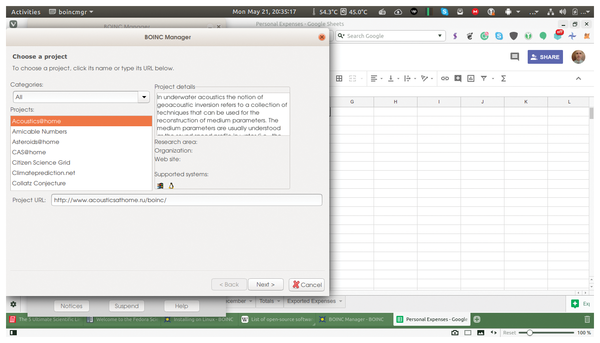
#Boinc projekty password
Provide the password as a command-line flag, e.g.To provide boinccmd with this password, consider one of the following: (For more information, see Systemd#Using units.) The first time BOINC starts, it will generate a password and save it to /var/lib/boinc/gui_rpc_auth.cfg. To start the BOINC service, use the provided rvice unit file. Provide boinccmd with a password for communicating with the service's RPC API.Two command-line management tools are available: boinccmd and boinc.
#Boinc projekty install
Install boinc-nox to use BOINC on a headless system. You may want to autostart that on Xorg startup. This can be accomplished by installing the package xorg-xhost (Extra) and executing the following command: In order to suspend GPU computing when the computer is in use, the boinc user should have access to your X session so that mouse/keyboard input can be communicated to the client. In addition, the boinc user should be in the video user group. To prevent computing errors, you most likely need the OpenGL (Multilib) package listed in Xorg#Driver installation. If you want to use your GPU, you may need the proprietary nvidia or amd drivers.įor newer AMD systems such as the Ryzen 5 2400G you can simply install opencl-amd AUR on top of the open source AMDGPU to provide OpenCL capability for GPU work.įor Nvidia, you also need the package opencl-nvidia located in extra.

(To avoid this, make sure the above steps regarding gui_rpc_auth.cfg have been done.) Go to menu option Advanced / Select computer, choose your machine's name and enter the password. If BOINC did not ask you to connect to a project, then make sure you are connected to the daemon. Do this via menu option Tools / Attach to project. You can attach to multiple projects if you have the resources (disk space, time, CPU power). NB, some projects will let you create an account remotely via the GUI while some may require you to first create an account via their website. To start the GUI, use the boincmgr commandīOINC should now take you through the process of attaching to a project. This can usually be achieved via the menu editor in your desktop environment of choice. If you make the file readable by the boinc group and ensure that the manager is run with /var/lib/boinc as the working directory, you should find that the client connects to the daemon automatically, as desired. BOINC Manager will also look for a readable gui_rpc_auth.cfg file in the current working directory. If you do not like the idea of having this file in your home directory, there is an alternative approach. If you prefer a different password, or none at all, you can edit /var/lib/boinc/gui_rpc_auth.cfg. $ ln -s /var/lib/boinc/gui_rpc_auth.cfg ~/gui_rpc_auth.cfgĭo not forget to add your user to the boinc group as described above and then relogin or reboot. To simplify connection of the GUI to the daemon, create a link to this file in your home directory.

Which will filter that message from rvice.īy default, a password is created in /var/lib/boinc/gui_rpc_auth.cfg for connecting to the daemon. LogFilterPatterns=~no authorization protocol specified

Until this is fixed, one workaround is to filter this message by creating the file /etc/systemd/system//nf, with the content On Wayland, and possibly also on X, you may notice a lot (one per second) of messages in the journal like:īoinc: Authorization required, but no authorization protocol specified To generate the necessary files referenced in the next section, make sure to start rvice.

You will also need to add yourself to the boinc user group in order for the manager to connect. The latter omits Xorg dependencies, and is therefore suited for use on headless servers.īoth packages install a unit file named rvice. Install either the boinc or the boinc-nox package. The intent of BOINC is to make it possible for researchers to tap into the enormous processing power of personal computers around the world. It was originally developed to support the project before it became useful as a platform for other distributed applications in areas as diverse as mathematics, medicine, molecular biology, climatology, and astrophysics. The Berkeley Open Infrastructure for Network Computing (BOINC) is a non-commercial middleware system for volunteer and grid computing. Use the idle time on your computer (Windows, Mac, or Linux) to cure diseases, study global warming, discover pulsars, and do many other types of scientific research.


 0 kommentar(er)
0 kommentar(er)
